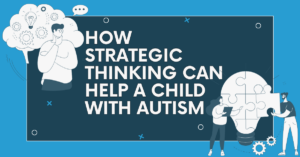
Introducing Abstract Concepts
Due to a tendency toward literal usage of speech, teaching strategic and abstract thinking to individuals with autism spectrum disorder (ASD) comes with its difficulties. However, developing more flexibility in thinking can help those with autism progress in their interpersonal skills and improve their quality of daily life. When teaching a child with autism, it’s important to remember to approach the situation with an open mind and avoid using idioms or figures of speech to minimize confusion during instruction.
ASD Strategic Thinking & “The Beauty Contest” Study
A 2016 study from Pantelis & Kennedy examines the nature of strategic thinking in people diagnosed with ASD. In the study, experimenters use “The Beauty Contest” economic game to compare the strategic depth of players with autism versus a control group of neurotypical players.
The game takes its name from a concept introduced by John Maynard Keynes in which beauty contest judges receive rewards for selecting the most popular contestants among other judges rather than those they believe to be the most beautiful. Keynes used this theoretical contest to describe similarities to investors’ actions in the stock market.
National Public Radio conducted a comparable contest by asking two groups of listeners to select one of three cute animal videos. The first group was asked to select the video they found the cutest, while the second group was asked to choose the video that they thought most other participants would select. The findings were consistent with Keynes’ conclusions that actual average opinion differs from the perception of average opinion.
Participants With Autism Found to Utilize Strategic Thinking
In the study by Pantelis & Kennedy, participants in “The Beauty Contest” chose a number between 0 – 100. Winners of the game were those who selected the number closest to ⅔ of the average
number chosen by all players. This game demonstrates strategic depth depending on the players’ perception of strategies used by other players. Pantelis & Kennedy’s experiment found that responses between the neurotypical control group and ASD participants were similar, with the average participant with autism using strategic thinking for their response.
Helping Children With Autism Develop Abstract Thinking Skills
Development of critical thinking skills can lead to a healthy sense of curiosity, which may foster growth in other areas as well. Though teaching strategic thinking skills to children with autism can be difficult, encouraging analytical thinking can help these children become more independent and self-reliant when making decisions and solving problems.
Visualizing Concepts
Although there are different types of learners, many individuals with autism can benefit from simplifying concepts into images. Using visual aids to support learning new concepts can help children overcome frustration with language while helping them build confidence and improve their understanding.
Visual aids might be:
-
Drawings
-
Photographs
-
Written words
-
Short videos
-
Figurines
-
Symbols
The gradual introduction of new concepts is an important factor when teaching with visual aids. Once a child begins to understand a concept, educators can then introduce another new idea until a visual collection forms over time. Returning consistently to these visualized concepts helps the child remember and retain what they learn.
Use Special Interests as Inspiration
When beginning new strategic thinking techniques, educators should try to personalize activities for the learner if possible. Using the child’s special interests to teach and communicate new ideas can help them focus on the task at hand.
Rating a Problem & Reaction
As those diagnosed with autism may have certain sensory sensitivities, it can be helpful to have a child rate their problems. This can help children understand that different problems need different responses. If a child can understand the scale of their problem, they may be more likely to try to find a solution themselves, if possible, or ask for help if the problem is too great.
Rules
Many children with autism work well within the boundaries of rules, and using rules to help children navigate social situations can help them overcome some of the “unspoken” rules of society that they may otherwise struggle with. Additionally, utilizing “if, then” statements can also help children understand the sequencing of events as well as consequences for rules that they do not follow. For
example, a teacher may tell a child, “If you finish your lunch, then you can play outside.”
Practice
As with the development of any new skill, practice is one of the best things for teaching critical thinking skills. Returning to activities that are cognitively engaging helps solidify new talents, and as children become more familiar with an activity, they may feel more confident in similar situations. After recognizing that a child feels comfortable with a task, using that same skill in another area or environment may assist the child in generalizing and applying their newfound ability in other areas of their life.
Sources Cited:
Pantelis, P.C., & Kennedy, D.P. Autism Does Not Limit Strategic Thinking in the “Beauty Contest” Game.
McPherson, Donnesa. Teaching Autistic Children Critical Thinking Skills.






